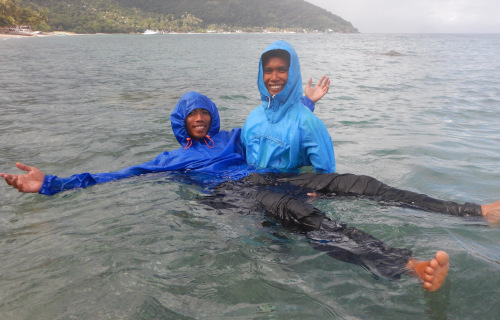Open Water Swimming Warm-up
Once you get to the beach, allow yourself enough time to warm up. There is a lot you can do to prepare your body for swimming, even if you avoid loosening up in the water.
A warm-up before open water swimming can help get your muscles working. It can be quite hard to get warm in open water especially when it's cold, so limbering up can really make a difference. A few press-ups, squats and arm swings should do the trick.
Always start a swimming session in dry clothes, as it can be brutal to put on the wet, cold and clammy clothes from a previous swim. Several sets of clothes let you enjoy more swim sessions and try out how they feel in the water.
First and foremost, check the temperature of the water where you will be swimming.
Decide if you can tolerate warming up in it without shivering yourself into a hypothermic state.
Cold Water Shock
Before you start your swim, it's a good idea to enter the water for a moment, even if it is cold, and accustom your body to the shock rather than deal with an icecream headache early in your swim.
When you sit on the edge, with your feet in the water, splash a little bit over your face. You will just get you used to the cold water before you fully jump in.
If you quickly jump into cold water you may feel like you can't breathe. This is simply because it is a shock to your body. After a couple of minutes your body will adjust.
In addition, your lungs natural reaction to cold water is to constrict at the shock, causing you to hyperventilate. By placing yourself calmly in the water you can allow your breathing to stabilize rather than deal with such extremities at the start of your open water adventure.
Make sure you are not tightening up your body in response to the water temperature. If you are shivering, your muscles will revert to being tight and thus cancel out your warm-up. This defeats the purpose of warming up and you should exit the water in favour of a land based warm-up.
Following on from this, you may want to enter the water slowly,
giving your body time to adjust to the change in temperature.
Wading in slowly allows your body to adjust as the water rises up and soaks your clothes.
A good way to relax is lie on your back and take some deep breaths.
This is really helpful to control your breathing and relax.
Then, do a few dozen strokes on your back to stretch out your shoulders and a few dozen breast-strokes to warm up your legs.
If you find it difficult to float on your back, maybe a friend can give you some support. Air bubbles in your clothes can give you extra lift.

Confidence
It is easy to build water confidence by just taking it one step at a time. A really good starting point is to fully submerge whilst blowing bubbles. This technique might sound odd but controlling your breathing whilst fully submerged can really help with your confidence.
Start off slowly and make sure you don't rush straight into a long swim especially if you're unsure about the open water. Aim for a buoy that's not too far away and then once you're at that buoy, take a little time, have a little breather before you decide whether you want to carry on or come back to the shore.
Swim about 100 easy strokes (equivalent to about 100 meters), then turn around and repeat the drill at a medium pace.
Do this twice (total: about 400 meters).